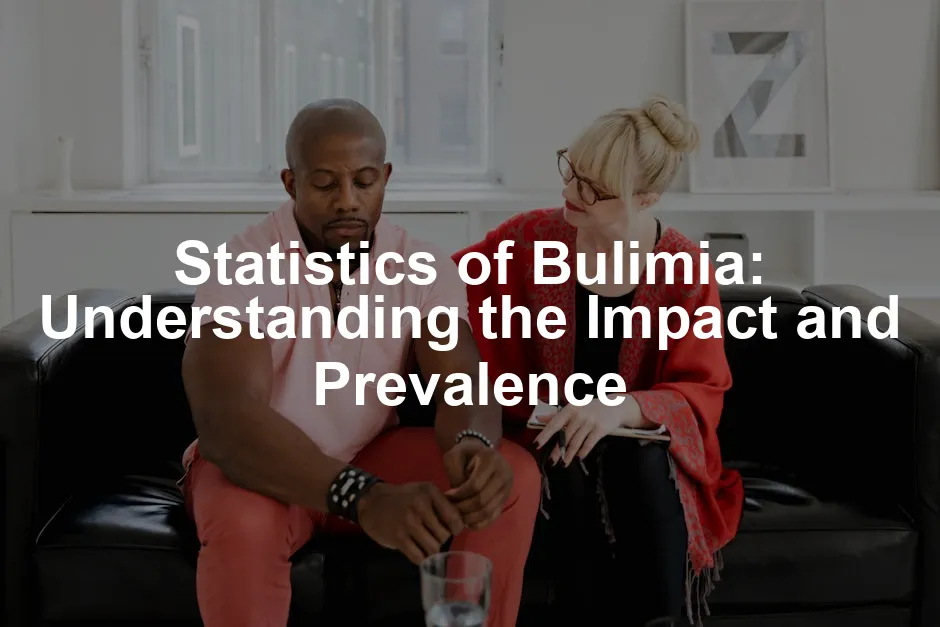Introduction
Bulimia nervosa, often just called bulimia, is a serious eating disorder. It is characterized by episodes of binge eating followed by compensatory behaviors. These behaviors can include self-induced vomiting, excessive exercise, or fasting. While bulimia may seem like a personal struggle, the statistics surrounding it tell a much larger story about its prevalence and impact. Understanding the statistics related to bulimia is crucial. Why? Because awareness can foster prevention and lead to effective treatment strategies. When we comprehend the numbers, we gain insight into the mental and physical toll of this disorder, both on individuals and society as a whole. The purpose of this article is to shine a spotlight on the statistics of bulimia. We will cover its prevalence, demographics, and the implications of these numbers on mental health. This information is vital for advocates, healthcare providers, and anyone who wishes to understand eating disorders better. Did you know that approximately 1.5% of women and 0.5% of men will develop bulimia at some point in their lives? These figures highlight the importance of addressing this issue head-on. By diving into the numbers, we can better advocate for those affected and work toward improving treatment options.
While we’re at it, if you’re looking to embark on a journey of self-care, consider grabbing a Self-Care Journal. It’s a fantastic way to reflect on your feelings and track your progress. Plus, who doesn’t love a bit of journaling therapy?
The Prevalence of Bulimia Nervosa
Key Statistics on Bulimia Nervosa
Bulimia nervosa is more prevalent than many realize. The lifetime prevalence rates suggest that about 1.7% to 2.0% of adult women and around 0.5% to 0.7% of men will experience this disorder. This disparity reflects not only biological differences but also the societal pressures that often target women more intensely. Demographics play a significant role in understanding bulimia. Adolescents, particularly females aged 12 to 19, are at a higher risk. Studies indicate that subthreshold bulimia affects between 2.0% and 5.4% of adolescent girls. Among ethnic minority youth, the prevalence is even higher, with rates reaching approximately 5.1% for girls and 2.3% for boys. These statistics reveal a pressing need for targeted interventions within these vulnerable groups. Age and gender are critical components in the analysis of bulimia. While women are more frequently diagnosed, it is essential to recognize that men are also affected. The growing awareness of bulimia in male populations is crucial, as societal stigma often leads to underreporting among men. Additionally, cultural factors influence the prevalence of bulimia. For example, the disorder is notably more common in Western countries, where media portrayal of ideal body types can trigger unhealthy behaviors. Young women, elite athletes, and individuals involved in weight-conscious activities face heightened risks. The statistics surrounding bulimia highlight the complexity of the disorder. These figures aren’t just numbers; they represent individuals battling a severe condition that can have lasting effects on their mental and physical health. Understanding these statistics is the first step in addressing the broader implications of bulimia nervosa. As we continue to explore the prevalence of bulimia, remember that these statistics paint a vivid picture of the disorder’s impact on society. Awareness and understanding can lead to change and ultimately provide support to those who need it most.
If you’re looking for insightful reading on mental health, consider picking up “The Body Keeps the Score: Brain, Mind, and Body in the Healing of Trauma” by Bessel van der Kolk. It’s a profound read that dives into the effects of trauma on our bodies and minds.
Regional Insights
Comparative Analysis Bulimia nervosa doesn’t discriminate—it can impact anyone, anywhere. Yet, prevalence rates vary significantly across regions and cultures. For instance, studies indicate that Middle Eastern countries have seen a staggering 22% increase in bulimia cases from 1990 to 2019. Bahraini youth reported a whopping 21% experiencing clinically significant bulimic symptoms. Meanwhile, Western nations often report lower rates, but they still present a concerning picture. In the U.S., lifetime prevalence averages around 1.5% for women and 0.5% for men. Certain demographics, such as young women and elite athletes, remain at higher risk. Interestingly, cultural attitudes toward body image can elevate these rates further, particularly among ethnic minorities. Research indicates that 5.1% of ethnic minority girls and 2.3% of boys are affected, showcasing a clear need for culturally sensitive interventions.
For those seeking a deeper understanding of eating disorders, “Eating Disorders: A Comprehensive Guide” by Carolyn Costin is an invaluable resource. It provides extensive insights into the complexities of these conditions and is a must-read for anyone interested in the subject. Check it out here.
Impact of COVID-19
Pandemic Effects Ah, the pandemic—who knew it would turn out to be a dietitian’s worst nightmare? Yes, COVID-19 has significantly impacted individuals with bulimia. Data reveals that 49% of those grappling with bulimia reported worsened symptoms during lockdowns. It wasn’t just their social lives that took a hit; their mental health plummeted, too, with 60% experiencing heightened anxiety and depression. The isolation, disruptions in routine, and uncertainty of the times created a perfect storm for worsening eating disorders. Emerging from this pandemic, it’s crucial to address not only the physical but also the psychological repercussions of such a global crisis. We must ensure that individuals struggling with bulimia receive the necessary support and resources to navigate these troubled waters.
Speaking of support, if you’re looking to enhance your self-care routine, an Weighted Blanket can be a game changer. It provides comfort and can help reduce anxiety—perfect for those stressful days.
Healthcare Costs and Access to Treatment
Economic Impact
Bulimia nervosa poses a significant financial strain on healthcare systems. Studies reveal that individuals with bulimia incur treatment costs that are typically twice as high as those without the disorder. For instance, a study from Taiwan indicated that healthcare expenses for bulimia nervosa patients were about 200% higher than for healthy individuals. This disparity highlights the severe impact of this eating disorder on both personal finances and public health resources. The high costs associated with bulimia arise from various factors. Frequent hospitalizations, outpatient therapy sessions, and specialized treatment programs contribute to an overwhelming financial burden. Additionally, individuals may face other health complications, such as gastrointestinal issues or dental problems, further escalating healthcare expenses. With these rising costs, it becomes increasingly important to address the economic implications of bulimia, pushing for improved access and affordability of treatment options.
In this economic climate, having a reliable Fitness Tracker can help you manage your health more effectively. It keeps you accountable and motivated—no more excuses!
Access to Treatment
Despite the evident need for treatment, many individuals with bulimia face significant barriers when seeking help. Stigma remains a major hurdle, often preventing individuals from reaching out for the support they need. The fear of judgment can be overwhelming, making it difficult for people to discuss their struggles openly. Moreover, there is a notable lack of resources available for individuals seeking treatment. Many communities do not have access to specialized care, particularly in rural or underserved areas. This can lead to long waiting times for appointments or an outright inability to find adequate treatment options. Statistics reveal that only 23.2% of individuals with eating disorders pursue treatment. Gender also plays a role in treatment-seeking behaviors. Research indicates that while 47% of women with bulimia seek help, only around 29% of men do the same. This discrepancy reflects the need for targeted outreach and education to encourage all genders to seek the assistance they require. In summary, addressing both the economic impact of bulimia and the barriers to accessing treatment is crucial. By improving awareness, reducing stigma, and expanding resources, we can help ensure that individuals with bulimia receive the necessary care to support their recovery journey.
Relapse Rates
Recovery from bulimia nervosa is a challenging journey. Approximately 17% of individuals may relapse after achieving recovery. That’s right—one in six people might find themselves back in the clutches of this disorder. Talk about a rollercoaster ride! Recovery isn’t just about quitting unhealthy behaviors; it’s about confronting the underlying issues that fuel them. Why is relapse so common? It often stems from ongoing mental health struggles. Individuals may face triggers like stress, societal pressures, or negative body image. These factors can make the road to lasting recovery bumpy. It’s essential to create robust support systems and coping strategies to navigate this tricky terrain.
Factors Influencing Recovery
Recovery from bulimia isn’t a one-size-fits-all scenario. Several influential factors play a role in how well someone can rebound from this disorder. First up is the person’s readiness for change. Individuals must genuinely want to alter their relationship with food and body image. Those who are more committed to change often experience better outcomes. Support systems also matter immensely. Friends, family, and professionals can provide the encouragement needed to stay on track. Studies show that individuals with strong support networks are less likely to relapse. They have someone to lean on during tough times, lending a much-needed boost when self-doubt creeps in. Statistics reveal that individuals with a higher level of confidence and readiness see more significant decreases in eating disorder symptoms. It’s not just about fighting the bulimia; it’s about fostering a positive self-image and nurturing mental resilience. Creating awareness around these influential factors can help guide individuals and their loved ones through the recovery process. Everyone deserves a chance to thrive, not just survive, on this journey!If you’re looking for additional ways to support your mental health, consider exploring “Daring Greatly” by Brené Brown. It’s a transformative read about embracing vulnerability and courage.

Conclusion
Understanding the statistics surrounding bulimia nervosa reveals its significant impact on individuals and society. The prevalence rates indicate that around 1.5% of women and 0.5% of men will experience this disorder in their lifetime. Even more concerning is the fact that 17% may relapse after recovery, highlighting the complexities of this eating disorder. The implications of these statistics are far-reaching. Bulimia is not just a personal battle; it’s a public health issue that demands urgent attention. The intertwining factors of mental health, social pressures, and cultural ideals create a perfect storm for this disorder to thrive. It’s crucial to foster a supportive environment for those affected, ensuring they have access to the resources they need. Raising awareness is key. By discussing bulimia and its statistics, we can encourage open conversations about mental health. Let’s break the stigma and create a safe space for individuals to share their experiences without fear of judgment. If you or someone you know is struggling with an eating disorder, don’t hesitate to seek help. Numerous resources are available, including therapy, support groups, and hotlines. The National Eating Disorders Association is a great starting point for finding support and information.And if you’re on the path to recovery and wellness, you might find a book on Intuitive Eating helpful. It’s about building a healthier relationship with food and your body.

Together, we can help those affected by bulimia find their way to recovery. Let’s champion mental health awareness and support one another on this journey to healing.
FAQs
Common Questions About Bulimia
Understanding the statistics of eating disorders, including bulimia, is essential for raising awareness. Statistics of eating disorders in race provide deeper insights into this critical issue.
Please let us know what you think about our content by leaving a comment down below!
Thank you for reading till here 🙂
All images from Pexels




